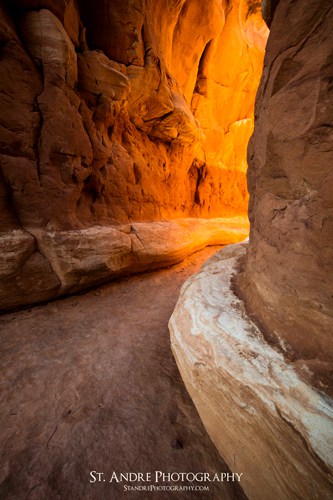Tips For Photographing Slot Canyons
Slot canyons are often dusty, so don’t plan on switching lenses (bring a zoom). Upside: Dust particles can create visible beams of light, which add wonder and energy to your image. Hide or crop out the beams’ endpoints to avoid direct sunlight splotches (as above). If there isn’t enough dust to see the beams, try tossing a handful of sand. Photographing Antelope Canyon Tips: If you're a fairly inexperienced photographer, photographing Antelope Canyon is going to be a massive challenge. Here's why: It's really dark It's really narrow The light changes with every turn You can't bring a tripod (unless you're on the photography tour) You can't bring a backpack (no space for different lenses etc - unless you're on the photography tour).
Canon 5DS R w/ EF16-35mm f/4.0 @24mm f/16 3.2s ISO 100
Tips For Photographing Slot Canyons Videos
Slot canyons of the American Southwest are famous for their otherworldly beauty. As such, they are high on many nature photographers’ bucket list. The best known and most visited are Upper and Lower Antelope Canyons near Page, Arizona.
With countless discussions in the gallery and my Navajo Nation Journey Workshop about 60 days from now, I thought it would be useful to compile a list of tips for slot canyon photography to share with others.
Ten tips for slot canyon photography

Challenges for slot canyon photographers seem endless. They include extreme dynamic range, low light focusing, long exposures, small spaces, and lots of dust. Although slot canyons present many challenges to photographers, the well-prepared and properly equipped photographer will not be disappointed. Here are ten tips for slot canyon photography success:

Two-shot pano: Canon 5DS R w/ TS-E 24mm f/3.5L II f/16 10.0s ISO 100
1. To the uninitiated, the insane circus that is Upper and Lower Antelope canyon can be very frustrating. Hundreds, if not thousands of tourists walk through these canyons each day during the summer season. If you go, prepare yourself mentally for fast pace, tight quarters, pushing, shoving, people in your frame, and guides barking out orders. However, there are many slot canyons that are not visited by the tour bus operators. These are the canyons where solitude, along with fantastic photo opportunities, can still be found.
2. Travel light. Even a small backpack will make it difficult to move around in narrow slot canyons.
3. Use a tripod. Although very colorful, these are low light environments. Shutter speeds of 20 to 30 seconds are not uncommon at ISO 100. Shutter speeds up to 120 seconds are sometimes necessary. Most cameras have a maximum shutter speed of 30 seconds. For anything longer you will need to use blub mode with a timing device, such as an intervalometer, to trip the shutter.
4. Stop down for maximum depth of field. Slot canyons twist and turn with layer upon layer of textures and colors. Don’t lose detail to shallow depth of field. Hyper focal distance can be an effective technique to maximize depth of field.
5. If you use auto focus, use single point mode with back-button focus. Multi-point modes will frequently lock onto surfaces other than which you intend. With back-button focus, you can choose your focus area and recompose for best results. Live-view manual focus also works well in this regard.
6. Learn to adjust your camera settings in the dark. Although you can bring a flashlight, it is one more thing to keep track of and carry. Preset as many settings as possible before you enter the canyon. My preferences include single point focus mode, evaluative metering, ISO 100, f/16, mirror lock-up, and Auto White Balance. Many photographers recommend white balance of 6500 to 7500K to achieve warmer tones. However, I prefer to make such adjustments in post.
Tips For Photographing Slot Canyons Canyon
7. Use your RGB histogram (rather than luminosity) and highlight warning (blinkies) to verify exposure. Colors in these canyons can over expose the red channel. Much detail will be lost if the red channel is blown out.
8. Dust is everywhere. Avoid changing lenses while in a slot canyon. Zoom lenses, rather than primes, are best due to their inherent flexibility. Although a medium telephoto lens can be useful for detail shots, I prefer to use a 16-35 or 24-70mm. If you have to change lenses, turn your camera off, keep the body pointed downwards and make it fast. Bring along a rocket blower for cleanup during and after your shoot. You might even want to bring a plastic bag to cover your camera while not in use or while changing lenses.


9. Wear sturdy boots, a wide brimmed hat, and dress in layers. The temperature at the bottom of a slot canyon can be 10 degrees F lower than topside. Also a surprising amount of sand and debris can blow in from above.
10. Don’t forget to look up. Sometimes the best compositions and light are overhead.
Canon 5DS R w/ EF16-35mm f/4.0L @ 21mm f/14 1.3s ISO 100
Slot canyons are some of the most challenging environments for the landscape photographer. But also they are some of the most rewarding. These tips for slot canyon photography will help you manage the technical aspects of photography while exploring the artistic opportunities around every curve. Whether you are looking for floor-to-ceiling compositions or abstract details, the options are endless.